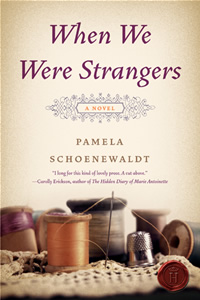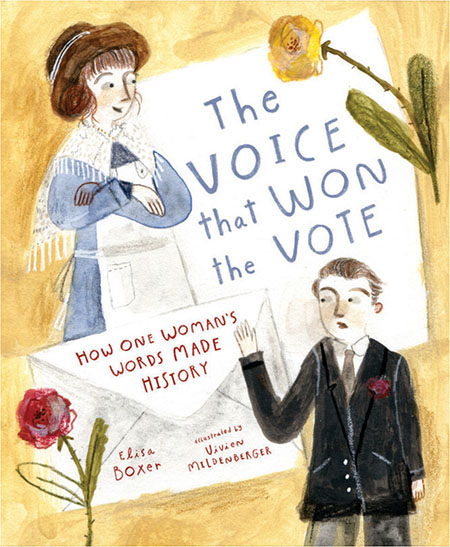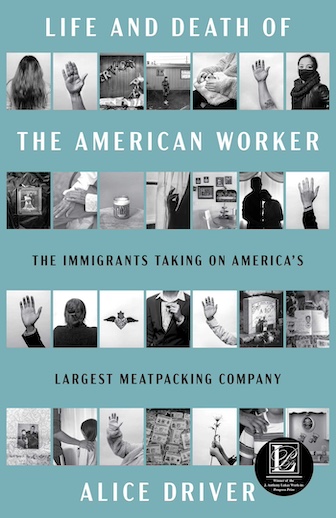Not of This Place
Pamela Schoenewaldt talks with Chapter 16 about immigrants’ stories and the art of historical fiction
When We Were Strangers, the debut novel of Knoxvillian Pamela Schoenewaldt, captures the risk and struggle of nineteenth-century immigration through the experience of a young Italian woman, Irma Vitale. Irma’s courage, hard work, and persistence are in many ways emblematic of all the immigrants who made their way to the U.S. during the 1800s. Those who survived the crowded, stinking conditions in the ships that brought them across the ocean found a reception that ranged from indifference to outright hostility. And often those who appeared to welcome them took advantage of their vulnerability and ignorance. Schoenewaldt never hides from this brutal reality, but Irma also finds support in surprising quarters and an inner strength that provides her with the will to make a life for herself in a country of strangers.
When We Were Strangers is a compelling, impeccably-researched story. It is also a reminder of one of the chief ironies of our nation’s history: that even in a nation of immigrants, an immigrant’s battle for acceptance and a place in society is almost always a harsh and bitter one. Schoenewaldt answered questions from Chapter 16 via email prior to her reading from When We Were Strangers on January 23 at the Hodges Library on the Knoxville campus of the University of Tennessee. Joining her will be Marina Maccari-Clayton of the UT History Department, whose specialty is Italian-American immigration history and who will discuss the historical context of Irma Vitale’s journey.
Chapter 16: Irma Vitale, the protagonist of When We Were Strangers, works as a representative of the nineteenth-century immigrant experience, in addition to being a vivid individual. Can you talk a bit about how you kept both of those roles in balance as you were writing?
Schoenewaldt: To create this duality—to place characters in history and to make them at the same time real, credible and individual—is the challenge of any fiction, even contemporary or fantasy fiction. In historical fiction, it’s important, I think, to have both respect for and a certain independence from history and sociology. Take, for instance, the fact that Irma comes alone to America. Single female immigrants, any immigration historian (like my own sister) would tell you, were not the statistical norm. But there were some. My task was to make Irma’s choice to leave Opi, the “push factors” immigration historians speak of, compelling. Given her complex of circumstances laid out in Chapter One, what made the choice to leave the world she knew inevitable for her?
Another part of the balance is to avoid anachronisms—and even the appearance of anachronism. Like grammar issues or character inconsistencies, they pull the reader away from the story. Yet no amount of historical veracity makes a difference if the reader doesn’t care about the character’s journey.
Chapter 16: The novel features both a rape and an abortion. Did you receive any negative feedback from readers over those depictions?
 Schoenewaldt: I feared more negative feedback than I actually received, to the point of discussing the option of a pseudonym early on in discussions with my agent. But in fact there has been little pushback, even from some Christian-fiction sites which reviewed When We Were Strangers. Like most women who choose to abort, this was not an easy option for Irma, even as a rape survivor, and I worked hard to show this. The rape scene, of course, was difficult to write, since in fiction, I believe, you must emotionally go to the places you take your character. It was hard, maybe harder, in a later scene to put myself in the place of the perpetrator. That’s an even darker place.
Schoenewaldt: I feared more negative feedback than I actually received, to the point of discussing the option of a pseudonym early on in discussions with my agent. But in fact there has been little pushback, even from some Christian-fiction sites which reviewed When We Were Strangers. Like most women who choose to abort, this was not an easy option for Irma, even as a rape survivor, and I worked hard to show this. The rape scene, of course, was difficult to write, since in fiction, I believe, you must emotionally go to the places you take your character. It was hard, maybe harder, in a later scene to put myself in the place of the perpetrator. That’s an even darker place.
In researching nineteenth-century contraception I discovered many things. First, that abortion was simply not a public-policy issue. Managing fertility was a women’s issue, and women tried desperately, with limited medical technology, to do this. Many, many died. I’ve read that having ten to twelve abortions in one’s fertile years was not uncommon. The possibility of dying in childbirth was also very real, and many mothers with children chose not to continue with an additional pregnancy because they feared leaving their living children motherless. Choosing adoption or orphanages often mean giving the child up to servitude or an early death.
The “infallible cure, Number 2” which Irma takes was a real product, one of many widely sold to “remove an obstruction” and/or “restore flow”—that is, to induce an early miscarriage. These were completely unregulated concoctions, sometimes fairly random, of terrifying toxins. Their efficacy in creating a miscarriage was questionable, and they often proved fatal or caused slow poisoning. Yet desperate women, married or single, of every social and economic level often turned to these measures.
My experience of most readers is that whatever their political or religious position in the current debate, they can enter into the options available with a character they care about.
Chapter 16: How did your time in Naples affect the development of the novel?
Schoenewaldt: During the ten years (1990-2000) I lived in a small town outside of Naples, my husband and I went cross-country skiing in Opi, and I was captivated by both the beauty and isolation of the village, as well as its limited opportunities for young people, even now. Imagine a young woman living on a mountaintop village more than a century earlier, before modern communications. On a practical level, some of the research I used was written in Italian, so knowing the language helped.
The experience of being a foreigner helped me connect with my character’s experience. Whether the people around you are welcoming or not, there is always a sense of being not of that place. This sense can be frightening, uncomfortable, isolating, as well as liberating, creative, intriguing, but it never goes away, and it profoundly impacts one’s sense of self. I tried to tap into those experiences in creating Irma’s story. I’ve blogged about various aspects of my own immigration experience and the wider immigration experience at www.PamelaSchoenewaldt.com.
Chapter 16: Many novelists report that researching a historical novel can overwhelm the imaginative side of writing. What was your experience of research? How did you decide you were finished?
 Schoenewaldt: You have to be fascinated by history to get into this line of writing, so the research process is itself involving. Once you have the basic plot and characters in mind, the research process can be enormously creative. Ideas emerge, lift off the history text (or website) as if you were passing a magnet over metal filings. Of course, the very fact of the fascination of the process poses challenges. Reading is much easier than writing so there is the temptation to put off writing to read one more text, explore one more avenue. At some point you must just put away the research and write.
Schoenewaldt: You have to be fascinated by history to get into this line of writing, so the research process is itself involving. Once you have the basic plot and characters in mind, the research process can be enormously creative. Ideas emerge, lift off the history text (or website) as if you were passing a magnet over metal filings. Of course, the very fact of the fascination of the process poses challenges. Reading is much easier than writing so there is the temptation to put off writing to read one more text, explore one more avenue. At some point you must just put away the research and write.
Your business is creative fiction, the journey of your character, and that must be paramount. Just the fact that you spent considerable energy and time chasing down one fact or find it fascinating doesn’t mean it deserves a place in the novel. Nothing should be there unless it serves the character’s journey, the pacing and plot needs of the section, and the point of view you have chosen. In my case, since this was first-person from Irma’s point of view, I had to be careful not to include material that she would not have noticed or cared about at that particular point in her journey. Having been immersed in your period, there’s a danger of assuming that facts which are now quite obvious to you are part of the general reader’s intellectual store. That’s where a writing group or several advance readers are invaluable.
In practice, I tended to research details for each chapter as I went, so my head wouldn’t be too full of factoids, and I’d have a better idea of the particulars I’d need for each stage of Irma’s journey. While there is obviously a lot available on the Internet, I found that it was often more efficient to use the expertise of a reference librarian to find information through specialized databases than to bomb around on the Internet and come upon material of questionable veracity.
Chapter 16: When We Were Strangers is not a polemic about immigration issues, but political pundits could certainly learn from it. Is there anything about the history of immigration to America that’s missing from the political debate today, in your view?
Schoenewaldt: Our human history is immigration since the emergence of our species, and our personal history, even those who live in their country of birth, includes many times in which we find ourselves in a “strange land”: going to college, a new job, relationship, parenthood, illness, and so forth. We are often in Irma’s situation. Specifically to immigration, the current vehement anti-immigration discourse is nothing new. There was ferocious opposition to immigrants from Southern Europe in the early twentieth century. “Experts” claimed “proof” that eighty percent of Southern Europeans were genetically disposed to being imbeciles, poor, and criminal. Now we have merely changed our target. And of course many who are so fervently “America for Americans” are themselves descendents of immigrants. How soon we forget. I recently discovered that more than eighty percent of those who came to the North American colonies before 1800 were indentured servants. So much for “searching for political and/or religious freedom.” They were trying to live, to create an acceptable life for their families, just like many of today’s immigrants.
I have heard from many readers who say that Irma’s story allowed them to connect with the immigrant journey of their relatives, some of whom would not or could not tell their own stories. And I hear often that this work of fiction gave them more sympathy for the immigrants of today. I think that’s one of the gifts of fiction—that it can enlarge our hearts. Tennessee readers interested in current immigration issues in the state might like to look up the work of the excellent organization, the Tennessee Immigration and Refugee Rights Coalition.
Chapter 16: What are you working on now?
Schoenewaldt: HarperCollins was very interested in a sequel to When We Were Strangers, but I felt that I had taken Irma to a place that felt complete to me. I had actually been thinking of returning to a medieval topic I’ve been working on, but as conversations developed, I got intrigued by following my first novel with another immigration story, set a little later, at the height of European immigration, the early twentieth century. So, drawing on my experience of Naples, my new protagonist is Lucia D’Angelo, who leaves Naples in 1906 with her gifted but troubled mother, goes to Cleveland, and is swept up in the drama of the 1911 Cleveland Garment Workers’ Strike. Publication is projected for the summer of 2013, which feels terrifyingly soon, although I do have the novel plotted out and am now on the fourth chapter.
Pamela Schoenewaldt will read from When We Were Strangers on January 23 at 7 p.m. at the Hodges Library on the Knoxville campus of the University of Tennessee. Marina Maccari-Clayton of the UT History Department, whose specialty is Italian-American immigration history, with join Schoenewaldt to discuss the historical context of the book.





